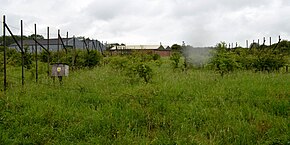Interplanetary Scintillation Array
 | |
| Part of | Mullard Radio Astronomy Observatory |
|---|---|
| Location(s) | Cambridge, Cambridgeshire, East of England, England |
| Coordinates | 52°09′47″N 0°02′04″E / 52.16315°N 0.034354°E |
| Organization | Mullard Radio Astronomy Observatory |
| Telescope style | radio telescope |
| | |
The Interplanetary Scintillation Array (IPS Array or Pulsar Array) was built at the Mullard Radio Astronomy Observatory in 1967 and originally covered four acres (16,000 m²).
The Interplanetary Scintillation Array was extended in 1978 to nine, and re-furbished in 1989. The array operates at 81.5 MHz (3.7 m wavelength), and is made up of 4096 dipoles in a phased array. 14 beams can map the northern sky in one day.
Sheep are used to keep grass away from the aerials as a lawnmower would not fit. It was designed by Antony Hewish to measure the high-frequency fluctuations of radio sources, originally for monitoring interplanetary scintillation. Antony Hewish received a Nobel prize after the high time-resolution of the array allowed the detection of pulsars by Jocelyn Bell in 1967.
The IPS has more recently been used to track and help forecast interplanetary weather, and specifically to monitor the solar wind. It is now essentially retired, and has lost significant fraction of its area. The telescope was operated by the Cavendish Astrophysics Group.

